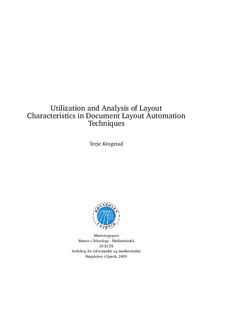| dc.description.abstract | The flow of information is continually increasing due to the ubiquitous use of information technology. Information communication and distribution is highly automated to meet the demand for an unobtrusive information flow. Servers, systems and applications overtake the tasks of gathering, storing, distributing and selecting the diverse information requests, though the task of presenting the information in a communicatively effective manner is still a manual tasks handled by professionals. In certain contexts, such as the distribution of dynamically generated content by web servers, the manual tasks restrict the system from performing as efficiently as possible. At the moment there is a great potential for production efficacy gain by automating the workflow to some extent. The system utilization of a document layout generator may cover some designer functions and thereby reducing task redundancy related to the presentation of information. Document layout automation algorithms are typically implemented with weighting metrics for the purpose of quantifying layout characteristics, also called layout attributes, of generated layout in the perspective of visual quality. Several different weighting metrics and algorithms have been studied and implemented in the past years, but still they fail to produce layouts matching the general performance of a designer in practice. Literature suggests that many of the weighting metrics, despite their advanced mathematical implementation, lack the implementation of a persistent set of preference attributes. Weighting metrics based on an extended set of preference attributes related to designer preferences may further improve the performance of a document layout automation algorithm. The scope of this thesis is to establish knowledge about the utilization of document layout attribute operators in document layout automation. How do document layout automation system with an extended attribute operator set perform related to layout quality? The study presented in this thesis reveals that implementing operators for the layout characteristics alignment and equilibrium in layout generators doesn’t automatically enhance the visually perceived quality of the layout generated. A second scope of this thesis is to generalize the modeling paradigms derived from existing literature related to document layout automation systems. Several systems have been proposed for solving layout automation related problems, but still there is a lack of literature related to the generalization of layout automation system models. Is it possible to recognize modeling patterns can be generalized an utilized in a wide range of layout automation systems, applications and / or components? We propose a layout automation system modeling framework based on a grounded theory study of related literature. The presented proof of concept system LaG is modeled based on this modeling framework and provides an affirmation of the modeling framework flexibility regarding layout automation technology and architectural modeling patterns. | en |
